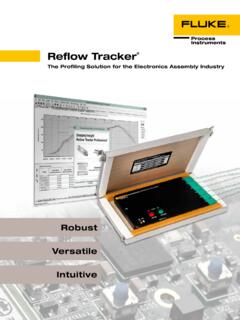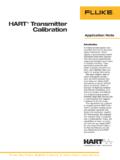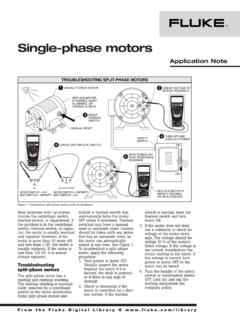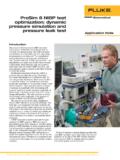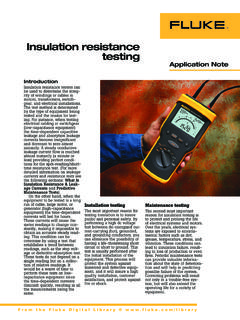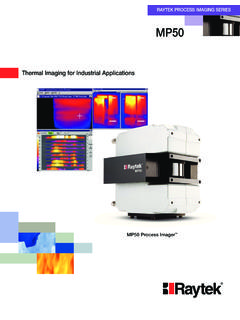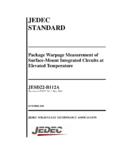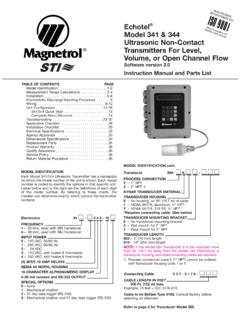Transcription of Principles of Non-Contact Temperature …
1 Principles of Non-Contact Temperature Measurement Author: Klaus-Dieter Gruner Contents Introduction Section 1 The Advantages of Using IR Thermometers Section 2 The Infrared Measuring System The Target Determining Emissivity Measuring Metals Measuring Plastics Measuring Glass Ambient Conditions Optics and Windows Detectors Displays and Interfaces Section 3 Special Pyrometers Fiber-optic Pyrometers Ratio Pyrometers Section 4 Bibliography and Further Reading 3. Introduction This manual was written for people who are unfamiliar with noncontact infrared Temperature measurement. A conscious attempt has been made to present the subject matter as briefly and simply as possible. Readers who wish to gain more in-depth knowledge can follow the suggestions for further reading in the bibliography. This manual focuses on the practical operations of noncontact Temperature measurement devices and IR thermometry, and answers important questions that may arise.
2 If you plan to use a noncontact Temperature measurement device and require further advice, send us the completed questionnaire (in the appendix) prior to use. Section 1 The Advantages of Using IR Thermometers Temperature is the most frequently measured physical quantity, second only to time. Temperature plays an important role as an indicator of the condition of a product or piece of machinery, both in manufacturing and in quality control. Accurate Temperature monitoring improves product quality and increases productivity. Downtimes are decreased, since the manufacturing processes can proceed without interruption and under optimal conditions. Infrared technology is not a new phenomenon it has been utilized successfully in industrial and research settings for decades but new innovations have reduced costs, increased reliability, and resulted in noncontact infrared sensors offering smaller units of measurement. All of these factors have led infrared technology to become an area of interest for new kinds of applications and users.
3 What are the advantages offered by noncontact Temperature measurement? 1. It is fast (in the ms range) time is saved, allowing for more measurements and accumulation of data (determination of Temperature field). 2. It facilitates measurement of moving targets (conveyor processes). 3. Measurements can be taken of hazardous or physically inaccessible objects (high-voltage parts, great measurement distance). 4. Measurements of high temperatures (greater than 1300 C) present no problems. In similar cases, contact thermometers cannot be used, or have a limited life. 5. 5. There is no interference no energy is lost from the target. For example, in the case of a poor heat conductor such as plastic or wood, measurements are extremely accurate with no distortion of measured values, as compared to measurements with contact thermometers. 6. There is no risk of contamination and no mechanical effect on the surface of the object; thus wear-free.
4 Lacquered surfaces, for example, are not scratched and soft surfaces can also be measured. Having enumerated the advantages, there remains the question of what to keep in mind when using an IR thermometer: 1. The target must be optically (infrared-optically) visible to the IR thermometer. High levels of dust or smoke make measurement less accurate. Concrete obstacles, such as a closed metallic reaction vessel, allow for only topical measurement the inside of the container cannot be measured. 2. The optics of the sensor must be protected from dust and condensing liquids. (Manufacturers supply the necessary equipment for this.). 3. Normally, only surface temperatures can be measured, with the differing emissivities of different material surfaces taken into account. Summary: The main advantages of noncontact IR thermometry are speed, lack of interference, and the ability to measure in high Temperature ranges to 3000 C. Keep in mind that only the surface Temperature can be measured.
5 Section 2 The Infrared Measuring System An IR thermometer can be compared to the human eye. The lens of the eye represents the optics through which the radiation (flow of photons) from the object reaches the photosensitive layer (retina) via the atmosphere. This is converted into a signal that is sent to the brain. Fig. 1 shows an infrared measuring system process flow. 6. Optics or window 453 . C. SP1 470 . C. EMS .85. Target Atmosphere Detector Display and interfaces Fig. 1: Infrared measuring system The Target Every form of matter with a Temperature (T) above absolute zero emits infrared radiation according to its Temperature . This is called characteristic radiation. The cause of this is the internal mechanical movement of molecules. The intensity of this movement depends on the Temperature of the object. Since the molecule movement represents charge displacement, electromagnetic radiation (photon particles) is emitted.
6 These photons move at the speed of light and behave according to the known optical Principles . They can be deflected, focused with a lens, or reflected from reflective surfaces. The spectrum of this radiation ranges from to 1000 m wavelength. For this reason, this radiation cannot normally be seen with the naked eye. This area lies within the red area of visible light and has therefore been called "infra"-red after the Latin. (See Fig. 2). Light Gamma Radio X-rays Ultraviolet Infrared rays SHF UHF VHF UKW KW MW LW ULW. 1A 1UA 100A 1 10 100 1cm 10cm 1m 10m 100m 1km 10km 100km Wavelength 1 2 3 4 6 8 10 15 20 30. Wavelength in m Infrared range used Fig. 2: The electromagnetic spectrum, with range from around to 14 m useful for measuring purposes 7. Fig. 3 shows the typical radiation of a body at different temperatures . As indicated, bodies at high temperatures still emit a small amount of visible radiation. This is why everyone can see objects at very high temperatures (above 600 C) glowing somewhere from red to white.
7 Experienced steelworkers can even estimate Temperature quite accurately from the color. The classic disappearing filament pyrometer was used in the steel and iron industries from 1930 on. The invisible part of the spectrum, however, contains up to 100,000 times more energy. Infrared measuring technology builds on this. It can likewise be seen in Fig. 3 that the radiation maximum move toward ever-shorter wavelengths as the target Temperature rises, and that the curves of a body do not overlap at different temperatures . The radiant energy in the entire wavelength range (area beneath each curve) increases to the power of 4. of the Temperature . These relationships were recognized by Stefan and Boltzmann in 1879. and illustrate that an unambiguous Temperature can be measured from the radiation signal. 1, 3, 4, 5. Fig. 3: Radiation characteristics of a blackbody in relation to its Temperature . 3. Looking at Fig. 3, then, the goal should be to set up the IR thermometer for the widest range possible in order to gain the most energy (corresponding to the area below a curve) or signal from the target.
8 There are, however, some instances in which this is not always advantageous. For instance, in Fig. 3, the intensity of radiation increases at 2 m much more when the Temperature increases than at 10 m. The greater the radiance difference per Temperature difference, the more accurately the IR thermometer works. In accordance with the displacement of the radiation maximum to smaller wavelengths with increasing Temperature (Wien's Displacement Law), the wavelength range behaves in accordance with the measuring Temperature range of the pyrometer. At low temperatures , an IR thermometer working at 2 m would stop at temperatures below 600 C, seeing little to nothing since there 8. is too little radiation energy. A further reason for having devices for different wavelength ranges is the emissivity pattern of some materials known as non-gray bodies (glass, metals, and plastic films). Fig. 3 shows the ideal the so-called "blackbody".
9 Many bodies, however, emit less radiation at the same Temperature . The relation between the real emissive power and that of a blackbody is known as emissivity (epsilon) and can be a maximum of 1 (body corresponds to the ideal blackbody) and a minimum of 0. Bodies with emissivity less than 1. are called gray bodies. Bodies where emissivity is also dependent on Temperature and wavelength are called non-gray bodies. Furthermore, the sum of emission is composed of absorption (A), reflection (R) and transmission (T) and is equal to one. (See Equation 1 and Fig. 4). A+R+T=1 (1). Target Heat source I. R Sensor T. Heat Source R A E. I = Impacting radiation R = Reflected radiation T = Transmitted radiation E = Emitted radiation A = Absorption Fig. 4: In addition to the radiation emitted from the target, the sensor also receives reflected radiation and can also let radiation through. 9. Solid bodies have no transmission in the infrared range (T = 0).
10 In accordance with Kirchhof's Law, it is assumed that all the radiation absorbed by a body, and which has led to an increase in Temperature , is then also emitted by this body. The result, then, for absorption and emission is: A!E=1-R. The ideal blackbody also has no reflectance (R = 0), so that E = 1. Many non-metallic materials such as wood, plastic, rubber, organic materials, rock, or concrete have surfaces that reflect very little, and therefore have high emissivities between and By contrast, metals especially those with polished or shiny surfaces have emissivities at around IR thermometers compensate for this by offering variable options for setting the emissivity factor. (See also Fig. 5). = (black body). = (gray body). changes with wavelength (non-gray body). Specific emission Wavelength in m Fig. 5: Specific emission at different emissivities Determining Emissivity There are various methods for determining the emissivity of an object.

